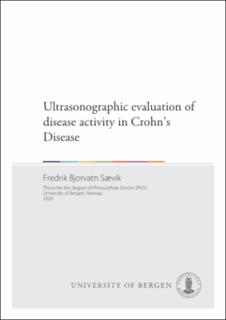| dc.contributor.author | Sævik, Fredrik Bjorvatn | en_US |
| dc.date.accessioned | 2020-09-15T07:58:31Z | |
| dc.date.available | 2020-09-15T07:58:31Z | |
| dc.date.issued | 2020-09-21 | |
| dc.date.submitted | 2020-09-01T18:06:22.248Z | |
| dc.identifier | container/63/9d/64/e7/639d64e7-2caa-481a-b143-1ea56190e422 | |
| dc.identifier.isbn | 9788230867907 | en_US |
| dc.identifier.isbn | 9788230866474 | en_US |
| dc.identifier.uri | https://hdl.handle.net/1956/24079 | |
| dc.description.abstract | Background: Crohn's disease (CD) is a chronic inflammatory disorder in the gastrointestinal (GI) tract, characterized by alternating periods of remission and relapse. Patients’ symptoms do not reliably represent inflammatory activity and management should be based on objective evaluation. Currently, ileocolonoscopy is the established reference standard method for both diagnosis and monitoring disease activity in most cases, but holds several limitations restricting repeated use. Consequently, there is a need for safe, objective and accurate methods to measure the degree of inflammation and treatment response. Gastrointestinal ultrasound (GIUS) is a promising modality in assessing disease activity and may be a useful tool for aiding physicians improving treatment decisions. Aims: The primary objective of the PhD project was to examine the usefulness of ultrasound in evaluating disease activity in patients with Crohn’s disease. Specifically, we aimed to investigate the ability of Dynamic Contrast-Enhanced Ultrasound (DCE-US) to provide information of treatment effects (paper I), to assess the diagnostic accuracy of GIUS in separating endoscopic remission from active disease (paper II), and to construct and validate a simple ultrasonographic activity index to quantify disease activity (paper III). Material and Methods: In paper I, 14 CD patients receiving medical therapy due to an acute exacerbation were examined with conventional- and contrast-enhanced ultrasound at four time points. In paper II, 145 CD patients scheduled for ileocolonoscopy were prospectively examined with GIUS within 2 weeks prior to or after the endoscopic procedure. The Simple Endoscopic Score for Crohn’s disease (SES-CD) was used as a reference standard. In paper III, 164 patients scheduled for ileocolonoscopy were prospectively examined with GIUS, identically performed as in paper II. 40- and 124 CD patients were included in the construction- and validation cohorts, respectively. Results: In paper I, we found significant differences in relative perfusion between responders and non-responders one month after treatment start. As a secondary finding, differences in bowel wall layers were revealed, where the proper muscle- and submucosal layers were significantly thicker in non-responders at one and three months after treatment initiation, respectively. In paper II, we found that bowel wall thickness measurements on GIUS had 92.2% sensitivity, 86% specificity and 90.3% accuracy in separating the disease status. By adding color Doppler in sections with increased wall thickness and fecal calprotectin in sonographic colitis, the diagnostic accuracy improved. In paper III, we developed a simplified ultrasound score consisting of bowel wall thickness and color Doppler. The ultrasound score correlated well with SES-CD in both patient cohorts (Development cohort: r=0.83, p<0.001, Validation cohort: r=0.78, p<0.001), and revealed excellent interobserver agreement (Development cohort: ICC=0.95.Validation cohort: ICC=0.90). Conclusions: We conclude that ultrasound is able to differentiate between patients with endoscopic remission and active disease, and a simple ultrasonographic scoring system is useful to evaluate the degree of endoscopic disease activity in CD. Furthermore, GIUS enables prediction of treatment effect shortly after treatment start, thus improving treatment decisions. | en_US |
| dc.language.iso | eng | eng |
| dc.publisher | The University of Bergen | eng |
| dc.relation.haspart | Paper I: Saevik F, Nylund K, Hausken T, Odegaard S, Gilja OH. Bowel perfusion measured with dynamic contrast-enhanced ultrasound predicts treatment outcome in patients with Crohn's disease. Inflammatory bowel diseases. 2014;20(11):2029-37. The article is not available in the thesis file. The article is available at: <a href="http://hdl.handle.net/1956/9025" target="blank">http://hdl.handle.net/1956/9025</a> | en_US |
| dc.relation.haspart | Paper II: Saevik F, Gilja OH, Nylund K. Gastrointestinal ultrasound can predict endoscopic activity in Crohn’s disease. Ultraschall in der Medizin. 2022;43(1):82-89. The article is not available in BORA due to publisher restrictions. The article is available at: <a href="https://doi.org/10.1055/a-1149-9092" target="blank"> https://doi.org/10.1055/a-1149-9092</a> | en_US |
| dc.relation.haspart | Paper III: Saevik F, Eriksen R, Eide GE, Gilja OH, Nylund K. Development and validation of a simple ultrasound activity score for Crohn’s disease. Journal of Crohn’s and colitis. 2021;15(1):115–124. The article is available at: <a href="https://hdl.handle.net/11250/2753218" target="blank"> https://hdl.handle.net/11250/2753218</a> | en_US |
| dc.rights | Attribution-NonCommercial-NoDerivs (CC BY-NC-ND) | eng |
| dc.rights.uri | https://creativecommons.org/licenses/by-nc-nd/4.0/ | eng |
| dc.title | Ultrasonographic evaluation of disease activity in Crohn’s Disease | en_US |
| dc.type | Doctoral thesis | |
| dc.date.updated | 2020-09-01T18:06:22.248Z | |
| dc.rights.holder | Copyright the Author. | |
| dc.contributor.orcid | https://orcid.org/0000-0002-9848-5186 | |
| fs.unitcode | 13-24-0 | |

